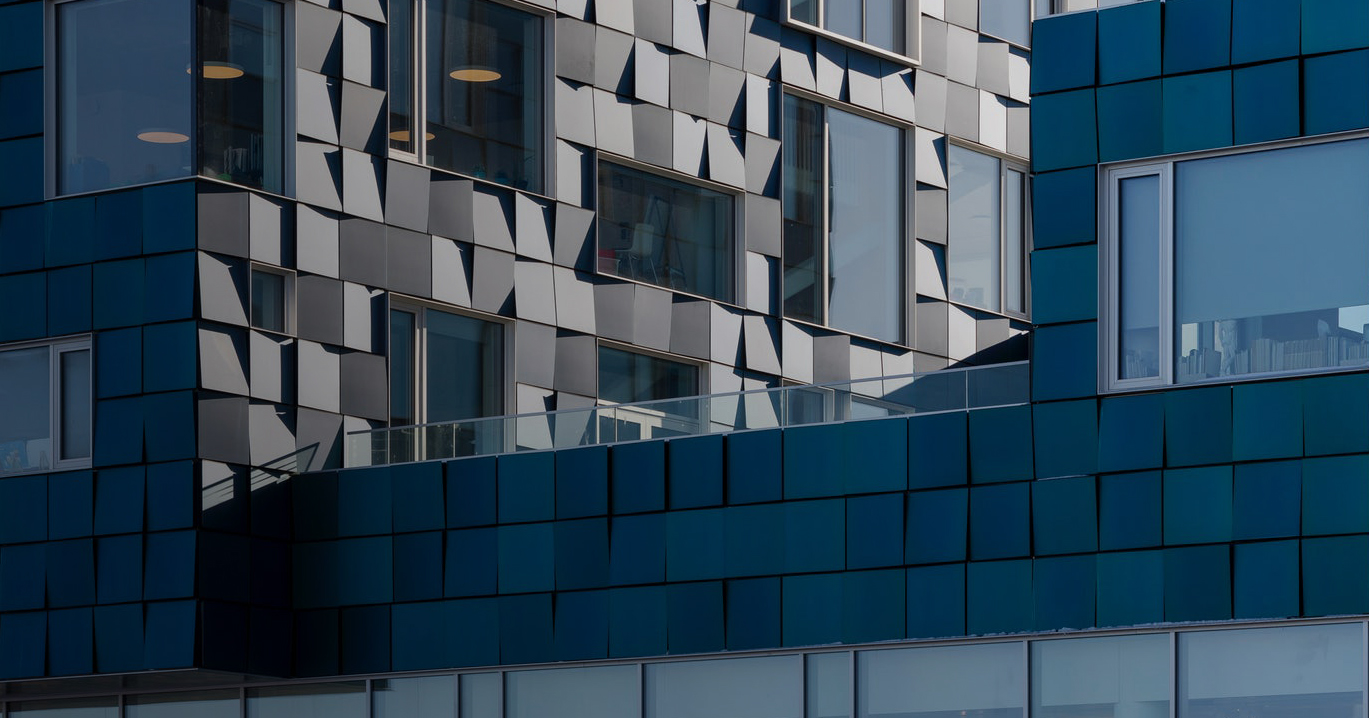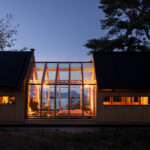Architizer's new image-heavy daily newsletter, The Plug, is easy on the eyes, giving readers a quick jolt of inspiration to supercharge their days. Plug in to the latest design discussions by subscribing.
The Copenhagen International School by C.F. Møller Architects is many wonderful things, but perhaps most remarkably, it is the architecture of willingness and foresight. With a façade encased in over 12,000 solar tiles, this project pushes well beyond carbon-neutrality while proving that a building can reject the dreary aesthetic that architects often associate with building-integrated photovoltaics. With deep pedagogical meaning, this school is not only a site of learning for the students within, but an indispensable resource for the wider world.
To understand this cutting edge façade, we spoke with Mads Mandrup Hansen, Partner at C.F. Møller Architects and Lead Architect on The Copenhagen International School project. Mandrup said, “What we wanted to do was to expose ourselves as a leader in sustainable design, but also create a truly sustainable project, not just for the sake of greenwashing. We thought that the architecture of the school should communicate many of the climate-based concerns that people are thinking about these days, all over the world.” This unprecedented building does just that.

© C.F. Møller Architects
The design for the Copenhagen International School encourages students to observe and interact with the solar tiles and their associated energy production on a daily basis.
The Copenhagen International School’s unique façade features 12,000 identical sea-green solar tiles that cover a total area of 6,048 square meters, supplying 300 megawatt hours of electricity per year — more than half of the school’s power needs. Forming one of the largest building-integrated solar power plants in Denmark, this phenomenal result was only possible through the collaboration of three distinct units: a willing client that saw a holistic vision beyond his immediate needs, architects equipped to create something drastic, and finally, an international community of manufacturers.
As Mandrup puts it, “the development of the glass happened in Switzerland, the manufacturing of the glass happened in Dubai, the intelligence behind the “back contact” — the part that harvests the electricity — happened in Taiwan, and the gluing together of all those parts happened in Croatia. We also wanted to make sure that it would be safe and able to withstand the exposed environment of Copenhagen’s outer-harbor. So we tested the panels at a climate lab in Spain, where we threw large gusts of wind at them. It was a truly global operation. The school continues to use this story to educate the students on how manufacturing occurs in this century.”

© Adam Mørk
Located on Copenhagen’s outer harbor, C.F. Møller Architects sought to create a building that would reflect its immediate landscape as well as provoke conservation around global climate concerns.
The process kicked off with a worldwide search for a manufacturer that could produce panels colored by light. According to Mandrup, it is very difficult to produce colored solar panels without reducing their energy efficiency, which is why we so often see them produced dreary gray and black colors. “We didn’t want this large-scale school to be a gloomy dark box, and those were many of the precedents we were seeing,” Mandrup said.

Colored solar glass panels created by the Ecole Polytechnique Federale in Lausanne; image via Lifegate
Determined to design something truly visionary, C.F. Møller Architects discovered Swissinso, a Swiss manufacturer of solar panels that works collaboratively with a small group of scientists at Ecole Polytechnique Federale in Lausanne (EPFL).
“EPFL has developed a special glass filter that allows the solar panel to take on one single color. The filter determines which wavelengths of light will be reflected as a visible color,” Mandrup said. The rest of the sunlight is absorbed by the solar panel and converted into energy. “After 12 years of research, they have figured out a way to do this without using pigment and without reducing the the energy efficiency of the glass. The science is very complicated, but the way it works is very similar to the Iris Effect, and how you sometimes see a colorful rainbow reflected on thin surfaces like soap bubbles.”
Today, these panels are produced in brick red, royal blue, golden yellow and sea green, as seen on the Copenhagen International School.

Left: while all 12,000 tiles are identical, they are angled at four different orientations to create a sequin-like effect; Right: detail image of the sea-green solar tiles
Fascinatingly, while the building looks like it is encased in three or four different hues, all of the panels are in fact the exact same color. “It just depends on the way the panel is angled, and how the sun hits its individual surface,” Mandrup said. To create the building’s stunning sequin-like effect, the architects tilted each panel at a 5-degree angle with one of four different orientations. Throughout the day, the moiré of colors shifts from blue to green, reflecting the water and crashing waves of the harbor. The design “has an ability to communicate the landscape, and plays with the idea of creating architecture that sets a scene.”

Diagram of the Copenhagen International School’s south-facing façade.
While C.F. Møller Architects played with differences in each panel’s angle and placement, there was no room for such variation when it came to the dimensions of each tile. The architects discovered that it was extremely important for each panel to be the exact same size — in this case, 70-centimeters by 70-centimeters.
“This has to do with the way that the electricity is harvested and how all of the tiles form an electrical circuit,” Mandrup said. “The whole system is very sensitive to irregularities. So once we found a way to give the tile color, we then worked on modulating the façade on Revit to identify the precise dimensions.”

Top: Façade prior to installing the solar tiles; Bottom right and left: During installation, the architects discovered that the building skin was quick and flexible to mount on, and that they could even start at one end, and then jump to another. Large cranes were used to attach each solar component.
As a result of time constraints, the solar panels were only mounted onto the school after the structural façades were completed. Fortunately, the small, uniform nature of the solar components allowed for a very quick and flexible installation process. The contractors used large cranes to attach each piece, moving around the school as they were finishing the interior. “It was a very flexible skin to mount on; you could even start in one end, and then jump to another,” Mandrup said.

© Adam Mørk
Interior image of the Copenhagen International School.
Ever since its completion, the school has been incredibly well-received by the students, as it allows for unique and exciting learning environment that completely alters the status quo. It is a model that could be replicated, time and time again. Not only will these architectural components reduce the building’s energy consumption, but it will also serve a larger purpose of educating a new generation.
“The school is used as a visual dashboard of real-time energy usage,” said Mandrup. “The building’s daily performance numbers show up on LCD screens throughout the interior of the school. These numbers are used in the children’s math classes, which allows even the youngest students to participate in a discussion on environmental issues. It has a pedagogical impact. It shows how we can really change the future if we are able to use solar cells as an integrated part of both buildings and education.”

© C.F. Møller Architects
South-facing façade of the Copenhagen International School. Although the solar tiles are uniform in color, they take on various hues depending on the angle of the sun.
When asked what he wants to witness in the future of building-integrated photovoltaics, Mandrup said that he hopes “we can create a new aesthetic of solar cells that moves away from the dreariness that architects often associate with them. With this project, we broke through a barrier, and realized that solar cells can be an extremely beautiful and colorful building component. We also showed that solar panels can go not only on the roof, but also all over the sides of a building. We think this project is a big page turner.”
Architizer's new image-heavy daily newsletter, The Plug, is easy on the eyes, giving readers a quick jolt of inspiration to supercharge their days. Plug in to the latest design discussions by subscribing.
All images courtesy of C.F. Møller Architects unless otherwise specified.






 Copenhagen International School Nordhavn
Copenhagen International School Nordhavn 


